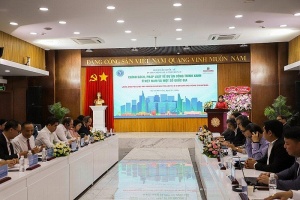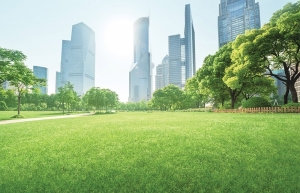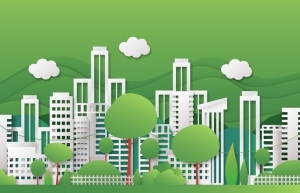Green buildings in Vietnam: Harnessing potential and advantages
The Ministry of Construction made this announcement at the plenary session of Vietnam Green Building Week 2024 on October 4 in Hanoi, which attracted over 1,000 participants, including government agencies, experts, and representatives from leading domestic and international businesses.
Promoting green building development
Green buildings, known for their minimal environmental impact, their role in promoting a green economy, and their ability to create healthy living environments while adapting to climate change, have become a national priority and a key part of Vietnam’s strategy for sustainable development.
 |
| Pham Minh Ha, Deputy Minister of Construction, giving remarks - Photo: Phuc Khang Corp. |
Speaking at Vietnam Green Building Week 2024, Pham Minh Ha, Deputy Minister of Construction, highlighted that in response to global and national challenges, Vietnam has introduced several policies to promote the development of energy-efficient, resource-saving, and environmentally friendly buildings. These policies also focus on reducing greenhouse gas emissions and advancing both the digital and green economy.
“Green building development is now one of the core tasks that the Ministry of Construction has been focusing on,” Ha said.
Some of the ministry’s initiatives include proposing regulations that promote the development of energy-efficient and green buildings, as outlined in the amended Law on Construction 2020 and Decree No. 15/2021/ND-CP on project management for construction investments.
Green building criteria have also been integrated into Resolution No. 26/2022/UBTVQH14, which focuses on urban classification and assessment. Additionally, the recently enacted Decree No. 95/2024/ND-CP, dated July 24, further incorporates green building criteria in the evaluation and classification of apartment buildings.
 |
| Vu Ngoc Anh- director of Department of Science, Technology, and Environment under MoC- giving remarks - Photo: Phuc Khang Corp. |
According to Vu Ngoc Anh, director of the Department of Science, Technology, and Environment under the Ministry of Construction, several action plans have been expedited to reduce greenhouse gas emissions. These efforts align with the draft plan for reducing emissions as approved by the prime minister.
“The potential for emission reductions in the construction sector from 2021 to 2030 is approximately 132.26 million tonnes of CO2 equivalent, leveraging domestic resources. With international support, this reduction could reach 238.11 million tonnes of CO2 equivalent,” Anh said.
Luu Thi Thanh Mau, CEO of Phuc Khang Corporation, a leader in Vietnam’s green building sector, highlighted the positive impact of recent regulations, including those outlined in Decree No. 95. She emphasised how these policies encourage green standards, increase asset value, reduce operational costs, and raise community awareness. They also provide opportunities for businesses to offer green technology and solutions while making it easier to access funding, as many investment funds now prioritise sustainable projects.
Potential and opportunities for green building investors
Thanh Mau also underscored the immense opportunities available for real estate investors in Vietnam’s green building market, both now and in the near future.
 |
| CEO Thanh Mau sharing insights at the Vietnam Green Building Week 2024’s plenary session - Photo: Phuc Khang Corp. |
“The potential for green real estate investors in Vietnam is vast, with many attractive opportunities emerging. Investors focusing on the sustainability of green real estate can achieve not only environmental goals but also take advantage of shifting market trends,” Mau said.
The growing emphasis on green buildings as a driver of the green economy is accelerating this shift. Green buildings help conserve energy and resources, reduce carbon emissions, and mitigate climate change by optimising natural light and ventilation to improve indoor air quality. They also create healthier living environments for residents.
These buildings further contribute to sustainable development by minimising environmental pollution and preserving natural landscapes. In addition, green buildings offer long-term economic benefits by reducing operational and maintenance costs.
During her talk at the plenary session, CEO Thanh Mau outlined several reasons behind the rise of green real estate in Vietnam. She noted the increasing demand for sustainable, eco-friendly living among both consumers and investors, who are prioritising environmentally conscious properties. Green real estate consumes less energy, has lower operational costs, higher resale value, and is easier to sell.
Moreover, the Vietnamese government is taking significant actions to promote green building development, with international partnerships and investments in green real estate gaining traction and making the market more attractive.
Recognising the importance of green buildings early on, Phuc Khang Corporation has positioned itself as a pioneer in international-standard green building development in Vietnam. The company views green buildings as essential to producing high-quality, sustainable products that align with global trends, helping spread the spirit of eco-friendly living and contributing to the country’s broader sustainable development goals.
Throughout its 15 years of growth, Phuc Khang Corporation has remained committed to pioneering a better living style that promotes community health and the sustainability of the ecological environment in line with global green standards.
 | Driving green building development in Vietnam from legal aspect Vietnam needs assessment tools and a roadmap to expedite green building projects, while introducing more incentive policies and increasing awareness about the benefits of green buildings among investors and consumers. |
 | Green building goals take gradual steps Buildings of a higher quality and with green certification are being more sought after by high-valued tenants. |
 | Vietnam intent on realising green building aspirations Although the amount of social housing in Vietnam is still very modest, the government and investors are determined to develop green social housing to meet market trends. |
What the stars mean:
★ Poor ★ ★ Promising ★★★ Good ★★★★ Very good ★★★★★ Exceptional
Related Contents
Latest News
More News
- The Kross ascends in Ho Chi Minh City's business heart (October 10, 2025 | 17:16)
- ESG-driven sustainability to define Vietnam’s green real estate (September 19, 2025 | 11:35)
- Tan Thuan Tower open for high value-added and innovative tenants (September 10, 2025 | 10:00)
- The new home of modern business at Hanoi's Starlake (August 19, 2025 | 08:00)
- Forum focuses on financial solutions for ESG in real estate (June 18, 2025 | 12:12)
- Frasers Property Vietnam moves towards green real estate leadership (May 08, 2025 | 11:25)
- Keppel collaborates with leading brands to enhance urban living in Vietnam (April 04, 2025 | 09:26)
- Strengthen partnership and efforts to promote zero energy buildings in Vietnam (February 26, 2025 | 17:31)
- Haus Dalat ESG real estate project holds opening ceremony (February 24, 2025 | 11:12)
- Best golfers awarded at Swing for the Kids 2024 (October 13, 2024 | 08:00)

 Tag:
Tag:



























 Mobile Version
Mobile Version